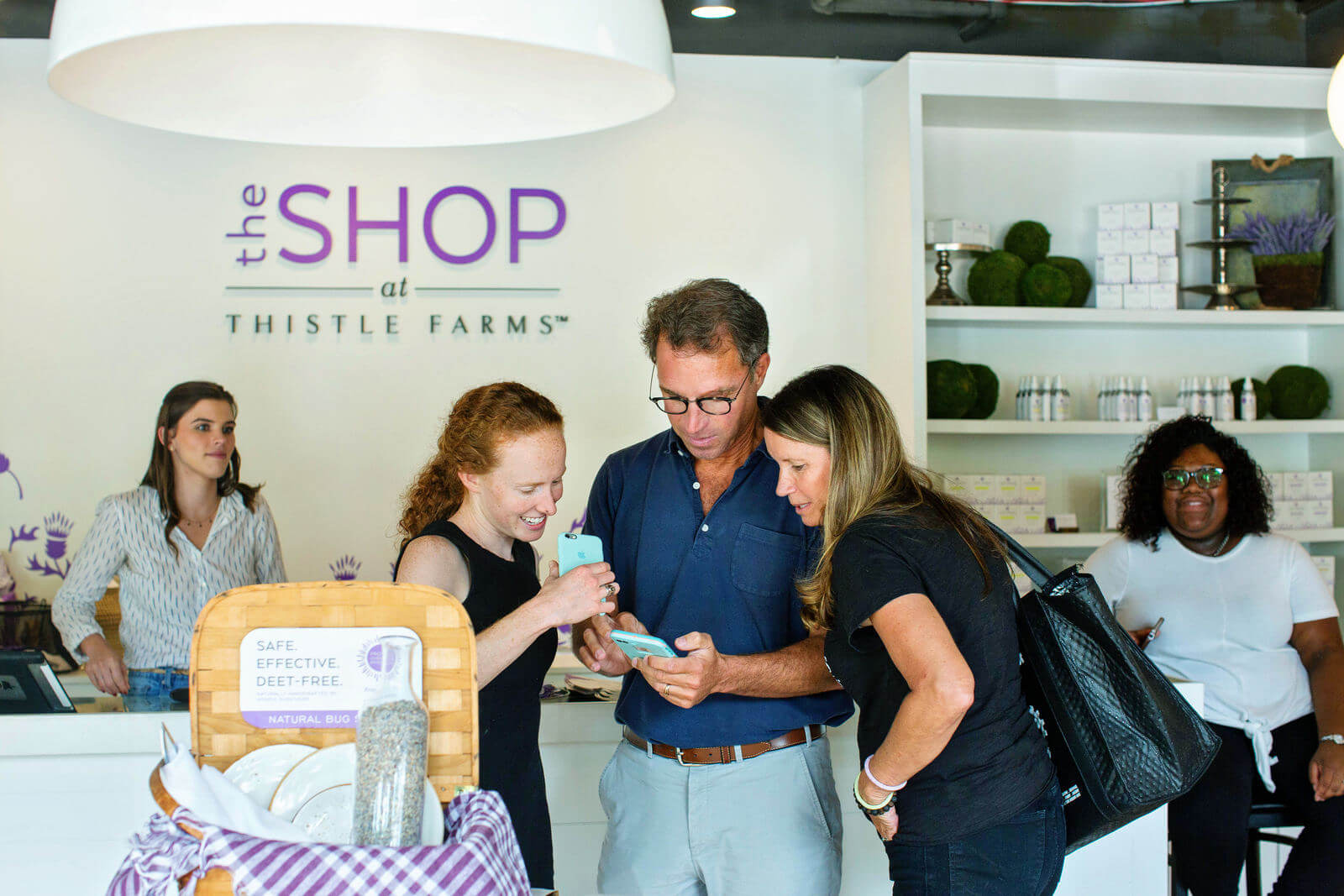Even if you haven’t lived in Nashville long, chances are you’ve heard of Thistle Farms, a nonprofit organization providing hope, healing, and freedom to women survivors of trafficking, prostitution, and addiction.
Earlier this year, Hal Cato announced he would be stepping down as CEO of Thistle Farms at the end of June. As his tenure at this beloved local nonprofit comes to a close, we wanted to check in on how Thistle Farms has grown over the last seven years, and how Hal has set up future success, all while keeping to founder Becca Steven’s vision. Hal’s experience offers an insightful overview of how a founder-led company or nonprofit can have a leadership change work well (when many don’t).
What is Thistle Farms?
If you’re unfamiliar with Thistle Farms, Becca Stevens started this nonprofit 25 years ago to help women survivors by providing housing, case management, healthcare, counseling, education, and employment for two years — free of charge. It’s supported through donations and social enterprise divisions, which employ women through Thistle Farms Body & Home, The Café and Shop at Thistle Farms, and the Global Shared Trade program.
These are women who typically first experienced sexual abuse between the ages of 7 and 11 years old, began using drugs and alcohol before they turn 13, and landed on the streets between 14 and 16. Despite those numbers, after five years, a staggering 75% of Thistle Farms graduates are living healthy, sober, and financially independent lives.
The organization has grown nationally and continues to serve as a sanctuary for thousands of women. In 2015, Becca welcomed Hal Cato to the organization as Chief Executive Officer, who adopted Becca’s original vision for Thistle Farms, then strategized and implemented ways to achieve growth.

Thistle Farms’ Growth Under Hal Cato as CEO
Becca reflects, “Seven years ago I looked at the year-end financials which stated Thistle Farms had surpassed four million in revenue and two million in product sales, and I thought to myself, ‘We need true leadership to enable Thistle Farms [to] be scalable and sustainable!’ At that time in the life of Thistle Farms, there was no job description, no search committee — just me at the back of St. Augustine’s Chapel where I serve as chaplain, stopping Hal Cato at the door and saying, ‘Hey, can you help Thistle Farms? We need you.’ Under his leadership, and with the hard work of so many kind and generous folks, we have more than doubled both our revenue and sales.”
When Hal first joined Thistle Farms, he says the organization was on the cusp of significant growth, so he was tasked with creating the structure and systems that would allow the company to continue to thrive. “What made it work between Becca and me — and what would be a model for other businesses — [was] having a lot of trust in one another, number one,” explains Hal. “I respected what Becca had created, and I was really clear on the understanding of ‘Okay, tell me about your sacred cows. What’s most important to you as we grow forward?’”
After gaining a clear understanding of Becca’s vision for Thistle Farms, Hal says it was important for Becca to have a hands-off role and allow Hal to take the necessary steps to grow the organization, which he says is an essential concept for any business owner to keep in mind if they’re seeking outside help. Hal also adds that it was important for the Thistle Farms staff to see Hal and Becca’s trust and open communication firsthand. After all, Hal was a male CEO joining an organization that assists women who (understandably) don’t trust men.
Hal describes his CEO role as intimidating initially; however, he also saw it as an incredible opportunity. “When I asked a woman in my interview point-blank, ‘How do you feel about a man coming in as CEO?’ She said, ‘My whole life, men have done nothing but buy, sell, and abuse me, and being able to trust one would be pretty cool,’” Hal reflects. “I remember thinking at that moment, ‘I’ve got to take this job for reasons I can’t explain.’”
After accepting his role as CEO of Thistle Farms, Hal set out to be a caring male presence for the women of Thistle Farms. He adds that he waited almost an entire year to start implementing his ideas, as his priority was to build trust with the women around him. “I learned a long time ago that people don’t care how much you know until they know how much you care, and so I just had to keep reminding myself of that,” Hal explains.



Throughout his time at Thistle Farms, Hal helped the organization grow in numerous ways — from putting an organizational structure in place that wasn’t there before and assisting the organization in its first capital campaign to investing in safe houses for women to live in and heal. However, Hal says one of his proudest accomplishments is helping create The Café and Shop at Thistle Farms as a place to further employ graduates of their program and provide the Nashville community with a space to be nourished, both physically and spiritually.
“We created a new café and a storefront that, last year, had 83,000 people come through the doors,” Hal tells us. “[We saw] tens and thousands of folks come through here because yes, the chicken salad is good, but the hospitality and the vibe here are even better.”
Upon Hal’s departure, Thistle Farms is dedicating and naming their seventh home in his honor, built using funds raised during a successful holiday season. The Cato House, slated to open in the coming weeks, will house eight women survivors. “What was wonderful was that all the women who worked hard to make and sell the products realized that their efforts just bought the land for the next house,” says Hal.
The Future of Thistle Farms
While the new CEO is scheduled to be announced in July, future growth and impact are assured with what is already in place:
- The organization has just invested in its manufacturing and distribution business, moving from a 9,000-square-foot facility to a new 22,000-square-foot space. This will allow Thistle Farms to expand its product line, including new wholesale channels and corporate gift offerings. They will partner with Batch — a locally based company that also moved into this new facility – to share staff and provide greater efficiency on shipping costs, future procurement, and more.
- The Thistle Farms model is currently being developed in 40 additional cities for a total roster of 92.
- Thistle Farms has opened an office in Washington, D.C. to focus on public policy, advocacy, and how they can be involved in the legislative process. This will help women survivors get their records expunged and regain their voting rights.
Of Thistle Farms’ current position, Becca says, “We are stronger and ready to scale to even greater heights because of Hal’s dedication and hard work.”

Takeaways for Nonprofits and Founder-Led Companies Looking to Change Leadership
There is much that other nonprofits and founder-led companies can learn from the example that Becca and Hal have set and their contributing strengths. Their trust has led Thistle Farms to grow sales by 190% over the last seven years, and it has grown contributed income — in the form of donations, grants, and non-cash donations — by 250%.
Hal’s advice is:
- The founder must be ready to step back and hand over the day-to-day reins. Becca was there. I’ve got friends working in other organizations where the founder thought they were ready but weren’t. It did not go well.
- Trust is everything. Take time to understand the founder’s “sacred cows” and keep them in mind when making big decisions. If that decision will impact one of those things, have that important conversation beforehand and not afterward.
- If possible, go slow with change in the early days. More than likely, your new employees will be watching to see how you honor the founder’s legacy. Nobody cares how much you know until they know how much you care. Make sure they know and trust you and understand your “why” before trying to pivot too hard or change too quickly.
During this time, Hal has positioned Thistle Farms to continue growing and thriving. He describes his time at the organization by saying, “It’s been the biggest honor of my life earning the trust [of these women] and growing an organization together.”
To learn more about Thistle Farms and its impact, visit thistlefarms.org.
All photography by Erica Baker.
**********
For the best “me moment” of the day, subscribe to StyleBlueprint! Click HERE.


















